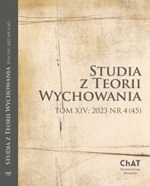Rzeczywistość medialna dzieci w wieku przedszkolnym
w opinii dzieci, nauczycieli i rodziców
The media reality of preschool children in the opinion of children, teachers and parents
Author(s): Eunika Baron-Polańczyk, Barbara WalasSubject(s): Social Sciences, Education
Published by: Wydawnictwo Naukowe ChAT
Keywords: media pedagogy; diagnostic and correlation research; pre-school children; media reality; media usage; media competences
Summary/Abstract: The article presents a fragment of diagnostic research of a mixed nature, establishing the media reality of preschool children. It seeks answers to the question about the media reality of preschoolers in the opinions of children, teachers and parents. The diagnostic survey method (questionnaire, interview, document analysis) and statistical methods (chi-square test of independence, ANOVA, Phi coefficient, Cramer's V) were used. The study examined 100 6-year-old children, 100 parents and 16 pre-school teachers. It was established that: 1) pre-school children: have unlimited access to the mobile applications; they use media tools in an uncontrolled way at home; in kindergarten, they learn the rational and correct use of new technologies while playing and learning; 2) parents and teachers assess children's media competency at an average level; parents see advantages and disadvantages in the media usage by children; 3) children can independently install games on a tablet or smartphone, often their parents install them themselves (usually these are games inappropriate for children’s age); 4) there are significant differences between the opinion of children and the observations of parents regarding the use of media tools; preschoolers claimed that they use tablets more often, and parents most often indicated that the children mainly watch TV; 5) calculations of differentiating factors showed significant statistical differences only in one case – between teachers' opinion on the children’s level of media competency and the teachers’ degree of professional advancement; the higher the degree of advancement, the lower the assessment of the competency level represented by six-year-olds. Artykuł przedstawia fragment badań diagnostycznych o charakterze mieszanym, ustalających rzeczywistość medialną dzieci przedszkolnych. Poszukuje odpowiedzi na pytanie określające rzeczywistość medialną przedszkolaków w opiniach dzieci, nauczycieli i rodziców. Zastosowano metodę sondażu diagnostycznego (ankieta, wywiad, analiza dokumentów) oraz metody statystyczne (test niezależności chi-kwadrat, ANOVA, współczynnik Phi, V Cramera). Zbadano 100 dzieci 6-letnich, 100 rodziców oraz 16 nauczycieli wychowania przedszkolnego. Ustalono, że: 1) dzieci przedszkolne: mają nieograniczony dostęp do aplikacji; korzystają w domu z narzędzi medialnych w sposób niekontrolowany; w przedszkolu uczą się racjonalnego i prawidłowego stosowania nowych technologii w trakcie zabawy i nauki; 2) rodzice i nauczyciele oceniają kompetencje medialne dzieci na poziomie średnim; rodzice dostrzegają w korzystaniu z mediów przez dzieci i wady i zalety; 3) dzieci potrafią samodzielnie zainstalować gry na tablecie lub smartfonie, często instalują je im sami rodzice (najczęściej są to gry nieodpowiednie dla wieku dzieci); 4) zauważalne są znaczące różnice pomiędzy opinią dzieci a spostrzeżeniami rodziców w zakresie stosowania narzędzi medialnych; przedszkolaki twierdziły, że częściej korzystają z tabletów a rodzice najczęściej wskazywali, że dzieci oglądają telewizję; 5) obliczenia czynników różnicujących wykazały istotne różnice statystyczne tylko w jednym przypadku – pomiędzy opinią nauczycieli na temat poziomu kompetencji medialnych dzieci a stopniem awansu zawodowego; im wyższy stopień awansu, tym niższe oceny poziomu kompetencji reprezentowanych przez sześciolatki.
Journal: Studia z Teorii Wychowania
- Issue Year: XIV/2023
- Issue No: 4 (45)
- Page Range: 181-198
- Page Count: 18
- Language: English

